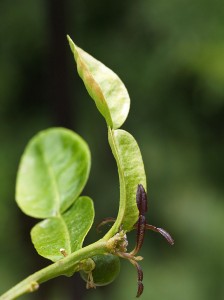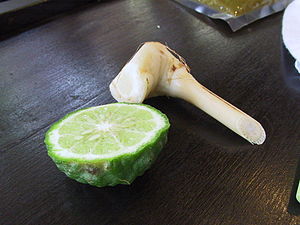When names offend — food edition

Kaffir lime leaves are used in some South East Asian cuisines such as Indonesian, Lao, Cambodian, and Thailand (มะกรูด).
Citrus hystrix leaf (Image by Fatrabbit, Creative Commons, Wikipedia)
Last week I blogged about Ottawa’s newest pro team, the Redblacks. As best I can tell, that name has nothing to do with the type of controversy associated with teams like the Washington Redskins. (Although one reader pointed out on a Facebook comment that I neglected to mention similar arguments about the Redblack’s mascot, “Big Joe” modeled after a real Francophone lumberjack.)
NCPR’s weekend guy Jonathan Brown and I exchanged a few emails on the topic. I admitted much fondness for the (unofficial) UC Santa Cruz mascot, the Banana Slug. And mentioned personal displeasure at how the University of Hawaii caved in on their long-honored insignia of a rainbow. (Emblematic of the many rainbows seen in wet Manoa Valley and for Hawaii’s rainbow of multi-ethnic cultural heritage.)
Just as I was thinking this sort of brouhaha is mostly confined to the world of sport, I read that a key ingredient in Thai cooking is in dire need of a less-racist name.
How many cooks and foodies out there are proud because they know about kaffir limes? (I use the leaves, which impart a quintessential flavor.)
But now I’ve learned the name “kaffir” is basically equivalent to the “n-word” in places like South Africa. Oh dear.
L.V. Anderson, assistant editor for Slate, writes about the whole issue here, including an attempt to track down how “kaffir” might mean different things:
As it happens, the very earliest written instance of kaffir lime yet to be uncovered suggests that the word’s origins have nothing to do with the South African slur. As the Oxford English Dictionary points out, Scottish botanist H.F. Macmillan used the term in his 1910 Handbook of Tropical Gardening and Planting to refer to a lime found in Sri Lanka, the home of the ethnic group that refer to themselves proudly as the Kaffirs. Macmillan lived there for 30 years, and it was there that he wrote his botanical handbook. It is difficult to say how he, and the other people he heard using the term kaffir lime, understood the connotation of the word, but it seems at least possible that the name began innocuously. Given that the earliest evidence of the lime’s name comes from Sri Lanka, lexicographer Jesse Sheidlower told me, “It seems very likely that it comes from that particular strand.”

Citrus hystrix Kabuyao (Cabuyao) fruit (left), used in Southeast Asian cooking, with galangal root. (Image by Fuzheado Creative Commons, Wikipedia)
Anderson says even if the origin of the name is free from malice, it rankles now. So maybe the safest thing to do is use what it’s called in Thailand: makrut.
Of course words mean different things – depending on time, place and the ear of the beholder, as explored in this June article by Geoffrey Nunberg “When Slang becomes a slur” for the Atlantic. Nunberg says it all shifted in the 1960’s:
That was when we collectively acknowledged that every group was entitled to control its own linguistic destiny, and decide what it should and shouldn’t be called—that groups had the right to define themselves.
“Redskin” has simply been the slang word the white man used for the Indian. Like all slang words, it was infused with the attitudes about the thing it names.
The principle had far-reaching consequences. When the decade opened, liberal-minded people referred to Negroes (or to “the Negro,” as LBJ liked to say), while an unreconstructed rear guard still talked about “coloreds.” By the decade’s end, pretty much everybody was using “blacks.” Over the following decades Orientals became Asians, queers became gays, and the new terms “Latino,” “Hispanic,” and “Chicano” were added to the vocabulary. And the old word “slur” acquired a new meaning to refer to a word that conveyed an ethnic or racial insult, one whose use was not just unkind, but as a social thought crime. Not even the vocal reactions against “political correctness” in later decades called the right of self-naming into serious question. Those on the cultural right may ridicule PC ideas about race and gender, but in their public discussions they’re as fastidious as anybody else about avoiding words that are regarded as offensive or simply outmoded.
This debate resonates in Canada too, over teams small and large, as shown by complaints about the Nepean Redskins (they changed the name) and the CFL’s Edmonton Eskimos.
A similar back-and-forth exists for the military’s policy of naming helicopters for tribes like Apache or Kiowa – criticized in this June op-ed in the Washington Post by Simon Waxman.
Hold on, says U.S. Army aviator Maj. Crispin Burke in his piece “Everyone Relax – The Army’s Native American Helicopter Names Are Not Racist“. Burke says “there’s a difference between honor and exploitation”:
Although not an official policy, Army officials typically name attack aircraft for tribes that historians have noted for their martial prowess. The RAH-66 Comanche, for instance, honored a tribe of mounted warriors that out-maneuvered, out-rode and out-fought the best-equipped U.S. Cavalry—a feat even more impressive when one considers the Comanche first encountered the horse only in the late 17th century.
So what evidence do we have to suggest that Native Americans aren’t offended by the Army’s tradition? Take, for instance, the fact that Army Material Command actually gets approval from Native American tribes before naming its aircraft. That’s according to the Department of the Army’s Pamphlet 70-3, paragraph 1-11-4-g, for you sadists out there.
Still not convinced? Well, consider that some Native American tribes don’t just approve of the Army’s naming convention, they give their outright blessing—literally.
In 2012, Native American leaders were on hand to bless two brand new LUH-72 Lakota helicopters—named for the nation which handed the Army one of its most notorious defeats at the Battle of the Little Bighorn in 1876.
The two helicopters, christened “Eagle” and “Turtle” for prominent Native American symbols, carry honor feathers in their cockpits, gifts from the tribe to the North Dakota National Guard.
Frankly, this tends to be a dangerous conversation. Debate opens up all kinds of name-calling, regardless of how individuals approach the topic.
Case in point: I am often offended by those who seem to want to control this discussion by suggesting anyone who disagrees is a racist. (Bad as racism is, politically correct bigotry is no more attractive.) To some extent I value freedom of expression more than some (utterly impossible) goal of making sure no one ever has hurt feelings.
Meanwhile, I’m trying to learn and remember “makrut lime”, because I see no need to make a freedom of speech issue over the other name. (I had no idea that word came with so much baggage!)
How do you decide which words to drop from your general vocabulary?
Tags: food, language, racism, social change, sports








Probably, if you search long and hard enough, every word has some baggage. I don’t believe I have ever been offended or shocked by any word. I will admit to having been made amused when someone tries to use a word, any word, to get a negative reaction from me.